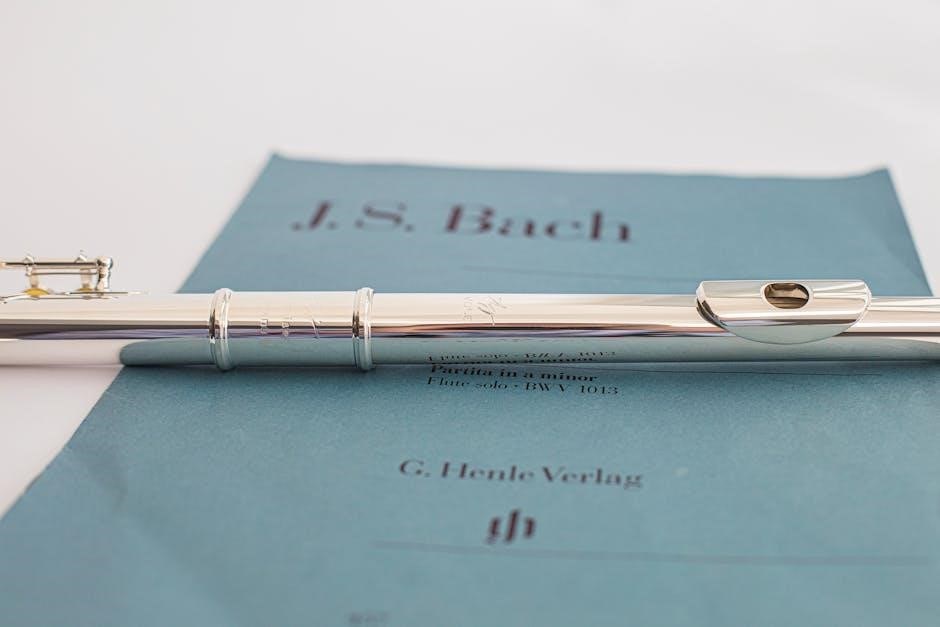J.S. Bach’s Toccata and Fugue in D Minor (BWV 565) is a renowned organ composition, celebrated for its dramatic toccata and intricate fugue, widely used in media.
1.1 Overview of the Composition
Bach’s Toccata and Fugue in D Minor (BWV 565) is a iconic organ work, blending dramatic toccata virtuosity with intricate fugue counterpoint. Its structure features a free-form toccata followed by a complex fugue, showcasing Bach’s mastery of both improvisational and structured composition, making it a cornerstone of organ repertoire and widely popular in media and culture.
1.2 Historical Significance and Popularity
Bach’s Toccata and Fugue in D Minor is one of the most recognizable organ works, widely used in films and media, enhancing its global appeal. Its dramatic opening and complex structure have made it a cultural icon, while its enduring popularity underscores its influence on composers and its educational significance in music studies.

Structure of the Toccata and Fugue in D Minor
The composition features a dramatic toccata with improvisational flair, followed by a complex fugue with interwoven melodic lines, creating a striking contrast between freedom and structured counterpoint.
2.1 The Toccata Section
The toccata section of Bach’s Toccata and Fugue in D Minor is a dramatic, improvisational-style piece, characterized by rapid arpeggios and bold chords. Its free-form structure, originating from the Italian word “toccata” (to touch), highlights technical virtuosity. The section begins with a iconic opening motive, featuring imitation and contrast, setting the stage for the fugue.
2.2 The Fugue Section
The fugue section in Bach’s Toccata and Fugue in D Minor is a complex, rule-bound composition featuring a distinct subject and answer. It begins with a single voice stating the subject, followed by others entering at different pitches. The fugue develops through episodes, showcasing contrapuntal mastery with themes inverted, fragmented, and overlapping, leading to a dramatic conclusion.
2.3 The Contrast Between Toccata and Fugue
The toccata and fugue sections present stark contrasts: the toccata is free-form, improvisational, and emotionally intense, while the fugue is structured, rule-bound, and intellectually rigorous. Their interplay creates a dynamic balance between ecstasy and discipline, showcasing Bach’s mastery of both expressive freedom and contrapuntal precision.

The Toccata Section in Detail
The toccata section, originating from the Italian word “toccare” (to touch), is a free-form piece showcasing technical skill. Its dramatic opening motif and improvisational style make it famously recognizable and widely used in media.
3.1 Origin and Evolution of the Toccata Form
The toccata emerged in the early Baroque era as a keyboard piece emphasizing virtuosic technique. Originating from Italy, it evolved to showcase a performer’s skill, often featuring improvisational elements. Bach’s Toccata and Fugue in D Minor exemplifies this form, blending dramatic flourishes with structured counterpoint, reflecting its historical development and artistic transformation over time.
3.2 Key Features and Improvisational Style
The toccata’s free-form structure mimics improvisation, showcasing technical brilliance. Bach’s version features dramatic flourishes, rapid arpeggios, and virtuosic manual dexterity, reflecting the Baroque era’s emphasis on showcasing a performer’s skill. Its opening motive and unpredictable rhythms create a sense of spontaneity, blending artistic expression with structural complexity.
3.3 The Famous Opening Motive
The Toccata’s opening motive is one of music’s most iconic phrases, featuring a dramatic descending scale in D minor. Its repetition at progressively lower pitches creates a sense of escalating tension. This motivic material, with its bold, virtuosic flair, has become synonymous with organ music and is widely recognized in popular culture.

The Fugue Section in Detail
The fugue section features a complex interplay of four distinct voices, showcasing Bach’s mastery of counterpoint. Its subject, marked by syncopations and leaps, undergoes transformations throughout the piece’s intricate development, including episodes and a dramatic conclusion.
4.1 Definition and Characteristics of a Fugue
A fugue is a contrapuntal composition where a subject is chased by multiple voices. Derived from Latin “fugere” (to flee), it features strict imitation, with each voice entering at different pitches, creating a complex yet harmonious structure. Bach’s fugues exemplify this form, blending intellectual rigor with artistic beauty, as seen in BWV 565.
4.2 The Fugue’s Subject and Answer
The fugue’s subject is a distinctive melody introduced by one voice, then imitated by others. The answer is the subject’s repetition at a different pitch, maintaining harmonic coherence. In BWV 565, the subject features syncopations and leaps, while the answer ensures thematic unity, driving the fugue’s intricate development.
4.3 Episodes and Development in the Fugue
The fugue features episodic passages that provide contrast and development. These episodes, often in different keys, showcase transformations of the subject, such as fragmentation or inversion. They connect and expand thematic material, maintaining interest while building toward the fugue’s climax. This dynamic interplay enhances the composition’s complexity and enduring appeal.

The PDF Sheet Music and Its Availability
The Toccata and Fugue in D Minor, BWV 565, is widely available as PDF sheet music on reputable sites like Free-scores.com and MutopiaProject.org, offering free and legal access to various arrangements.
5.1 Sources for Downloading the PDF
Free-scores.com, MutopiaProject.org, and mfiles.co.uk offer free, legal PDF downloads of Bach’s Toccata and Fugue in D Minor. These sites provide high-quality scores, including arrangements for various instruments, ensuring easy access for musicians and enthusiasts worldwide.
5.2 Arrangements and Transcriptions
Bach’s Toccata and Fugue in D Minor is available in various arrangements, including solo viola, flute duet, and orchestral versions. Transcriptions like Leopold Stokowski’s orchestral adaptation broaden its appeal. Many arrangements are freely available on platforms like MutopiaProject.org, offering musicians diverse interpretations and creative performance options.
5.4 Legal and Free Access to the Score
The Toccata and Fugue in D Minor is publicly available for free due to its status in the public domain. Websites like Free-scores.com and MutopiaProject.org offer legal PDF downloads, allowing free distribution, modification, and performance of the score, making it accessible to musicians and enthusiasts worldwide.

Performance and Interpretation
Bach’s Toccata and Fugue in D Minor demands precise organ technique and interpretation. Historically, it was played on organs with limited pipes, challenging performers to achieve its dramatic effect. Modern arrangements, including orchestral versions, expand its interpretive possibilities.
6.1 Organ Requirements and Historical Context
Bach’s Toccata and Fugue in D Minor was originally performed on Baroque-era organs with limited 8-foot pipes, resulting in a relatively modest sound. The piece’s dramatic nature demands precise registration and pedal technique, reflecting the historical organ’s capabilities. Modern interpretations often utilize larger organs or orchestral arrangements to enhance its grandeur.
6.2 Challenges in Playing the Toccata and Fugue
Performing Bach’s Toccata and Fugue in D Minor demands exceptional technical skill due to its rapid arpeggios, intricate pedal work, and complex counterpoint. Musicians must master precise articulation, dynamic control, and seamless coordination between hands and feet; The fugue’s layered voices require clarity and balance, making it a true test of organ mastery.
6.3 Modern and Orchestral Arrangements
Bach’s Toccata and Fugue in D Minor has been reimagined in various modern and orchestral arrangements, most famously by Leopold Stokowski. His symphonic version amplifies the piece’s dramatic impact, making it a staple in film scores. Arrangements for flute duets, viola, and other ensembles further showcase its adaptability and enduring appeal.

The Legacy and Cultural Impact
Bach’s Toccata and Fugue in D Minor has left an indelible mark on music and culture, becoming a cliché in film and media, symbolizing drama and grandeur universally.
7.1 Use in Film and Media
Bach’s Toccata and Fugue in D Minor has become iconic in film and media, featured in movies, video games, and orchestral arrangements. Its dramatic opening is widely recognized, notably in Disney’s Fantasia and various horror films, cementing its association with grandeur and suspense in popular culture.
7.2 Influence on Other Composers
Bach’s Toccata and Fugue in D Minor has inspired countless composers and arrangers, with its dramatic structure and contrapuntal mastery influencing works across genres. Transcriptions for solo instruments and orchestral arrangements, like Stokowski’s version, highlight its enduring appeal and versatility, while its educational significance continues to shape musical training and composition.
7.3 Educational Significance
Bach’s Toccata and Fugue in D Minor is a cornerstone of music education, teaching counterpoint, form, and technical performance; Its use in lesson plans and analyses helps students grasp Baroque techniques, while its availability as free PDF sheet music makes it accessible for study and interpretation by learners worldwide.

Counterpoint and Its Role
Counterpoint is a fundamental element in the fugue, where each voice is equal and independent, showcasing Bach’s mastery and the complexity of Baroque music composition.
8.1 Definition and Basics of Counterpoint
Counterpoint is the interweaving of multiple independent melodic lines, creating a rich harmonic texture. It involves the simultaneous interaction of voices, each maintaining its own integrity while blending harmoniously with others, often following strict rules to ensure coherence and balance in composition.
8.2 Counterpoint in the Fugue Section
In the fugue section, counterpoint is masterfully employed through the interplay of four distinct voices. Each voice enters with the subject or answer, creating a complex yet cohesive structure. Bach’s use of imitation, inversion, and stretto showcases his genius, blending individual melodic lines into a unified harmonic tapestry.
8.3 Bach’s Mastery of Counterpoint
Bach’s genius shines in his flawless use of counterpoint, where multiple independent melodies intertwine seamlessly. His innovative techniques, such as imitation, inversion, and stretto, demonstrate unparalleled skill. The fugue’s intricate design, with voices entering at different pitches, showcases his mastery, blending complexity with clarity and balance, setting a benchmark for future composers.
The Toccata and Fugue in D Minor BWV 565
Toccata and Fugue in D Minor (BWV 565) is a cornerstone of organ repertoire, composed between 1704 and the 1740s, blending dramatic toccata and intricate fugue, showcasing Bach’s genius and enduring popularity.
9.1 The BWV Catalogue and Its Significance
BWV stands for Bach-Werke-Verzeichnis, a comprehensive catalogue of Bach’s works. BWV 565, assigned to the Toccata and Fugue in D Minor, ensures its recognition and study within Bach’s extensive oeuvre, aiding scholars and musicians in organizing and understanding his contributions to Baroque music.
9.2 Debates Over Authorship
Despite BWV 565’s attribution to Bach, scholars debate its authenticity, suggesting it may have been composed by another Baroque musician like Buxtehude or a lesser-known contemporary, due to stylistic differences and the absence of an original manuscript.
9.3 The Piece’s Place in Bach’s Oeuvre
BWV 565 stands as a pivotal work showcasing Bach’s mastery of counterpoint and organ technique, though its exact placement in his oeuvre is uncertain due to ambiguous dating, making it a subject of both admiration and scholarly scrutiny within his extensive compositional legacy.
Bach’s Toccata and Fugue in D Minor remains a timeless masterpiece, enduring through its dramatic composition, cultural impact, and educational significance, ensuring its lasting appeal across generations.
10.1 Summary of Key Points
Bach’s Toccata and Fugue in D Minor (BWV 565) is a iconic organ work, blending dramatic toccata improvisation with a complex fugue. Its origin and authorship are debated, but its impact on music, film, and education remains profound. The piece showcases Bach’s mastery of counterpoint and continues to inspire performers and composers worldwide.
10.2 Final Thoughts on the Composition’s Enduring Appeal
Bach’s Toccata and Fugue in D Minor captivates with its dramatic contrasts and structural brilliance. Its timeless appeal lies in its emotive power, technical complexity, and versatility across media. As a cultural icon, it continues to inspire, making it a cornerstone of classical music’s enduring legacy.